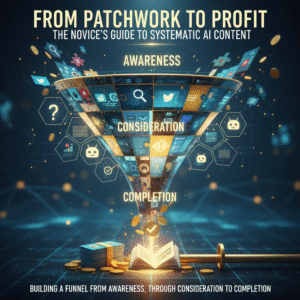From Patchwork to Profit: The Novice’s Guide to Systematic AI Content, building a funnel from awareness , through consideration to completion
Post by Peter Hanley coachhanley.com
This series explored how major companies move beyond quick-fix AI prompts to build powerful, scalable marketing systems. The good news? The most valuable lessons are incredibly simple, and any blogger, affiliate marketer, or small business owner can apply them immediately.
If you’ve been posting isolated content, seeing inconsistent results, or feeling overwhelmed by AI options, this is your blueprint to finding focus and building authority faster.
Your Funnel, Simplified: Awareness to Conversion
Forget the jargon. Your marketing funnel is just a path for your reader. Your goal is to keep them moving from one step to the next until they take action (buy the affiliate product, sign up, or purchase your service).
| Stage | Goal | Novice Application |
|---|---|---|
| Awareness | Establish Authority & Trust | Publish content that proves you are the expert in your niche (The Cluster). |
| Consideration | Nurture and Qualify | Follow up with consistent, relevant emails that speak directly to their problem (The Flow). |
| Conversion | Drive the Final Action | Test your headlines and calls-to-action (CTAs) to ensure you’re using the best possible language to ask for the sale (The Test). |
The systematic approach simply ensures that your AI helps you execute these three steps with maximum consistency and efficiency.
7 Essential Rules for Building Your AI Authority System
Here are the seven lessons you can apply today to move your marketing from chaotic guesswork to predictable growth:
1. Stick to One AI Engine (Build a Memory)
The temptation is to jump between free or different AI tools every day. Stop the flitting. If you only use one AI engine for your domain (whether it’s a specific model via API or a favorite web tool), the model starts to build a consistent internal memory and context about you and your brand. This repetition creates the stable foundation your system needs.
2. Authority is Built by Clusters, Not Single Posts
The days of randomly posting a single article on “keto diets,” then one on “garden tools,” and then one on “stock tips” are over. Posting single articles on a range of subjects makes you an expert at none. To rank high, Google needs to know you understand your complete subject (e.g., all 50 aspects of “keto diets”).
- Action: Build your content around a Pillar piece—one massive, definitive guide. Then, create 5 or more supporting blog posts (your Topical Cluster) that dive deep into specific, long-tail keywords related to that pillar. This demonstrates authority.
3. Consistency Builds Trust
Trust naturally follows authority. When a reader sees your site, they need to know you fully understand the topic. When every post is interconnected and references the others (like the cluster we just discussed), the reader instantly recognizes that your content is deep and reliable.
4. Put Guardrails Around Your Content (The Brand Voice)
Your single most important piece of infrastructure is your Brand Voice Guardrail. If you don’t tell the AI how to talk, it will sound generic. Before you generate any content, define the following for the AI:
- Tone: Are you an energetic cheerleader, a calm mentor, or a precise analyst?
- Style: Do you use short sentences? Do you use contractions?
- Avoid: What jargon words or phrases do you forbid?
This simple step ensures a singular focus is maintained across all media.
5. Maintain a Single Voice Across All Media
Your voice must be identical everywhere. If a reader finds your blog post (Awareness Stage), clicks through to your email sequence (Consideration Stage), and lands on your sales page (Conversion Stage), the voice and message must be consistent. This is a non-negotiable step to avoid confusing and alienating your audience.
- Action: Build your system around your CRM (or simple email list tool) and create an email flow that follows the exact same voice as your blog posts.
6. Close the Loop: Feed Information Back to AI
This is the secret to automating improvement. The AI needs to know if its work failed or succeeded. If an AI-generated headline got a low click-through rate (CTR), that language style is bad. If an email subject line got a high open rate, that style is good.
- Action: Get into the habit of reviewing your best and worst performers. When prompting the AI for a new piece of content, give it the feedback: “Do NOT use language like [Bad Headline]. DO use language like [Good Headline].”* This simple act of feeding information back to the AI for new and more concise actions automates your learning.
7. Always Be Testing (and Learning)
Testing should not be an occasional event; it should be part of the system. The most high-leverage areas to test are your headlines (Awareness) and your Calls-to-Action (CTAs) (Conversion).
- Action: Use A/B testing on all headlines and take action on the results. Bring AI into the loop to create better understanding and, hence, better words. The winning language from your tests should immediately update the “Good Language” in Rule #6.
Your Next Step
These are all things that even a novice can apply to achieve a higher authority ranking. You’ve already done the hardest part—understanding the system. Now, pick one element (like defining your Brand Voice Guardrails from Rule #4) and apply it to your next five posts.
Would you like to draft a simple, “Brand Voice Guardrail” prompt right now that you can start using consistently. Ask your AI to do it for you.
This blog, images, and logos built on the Wealthy Affiliate platform and using Google Gemini for research and writing support

